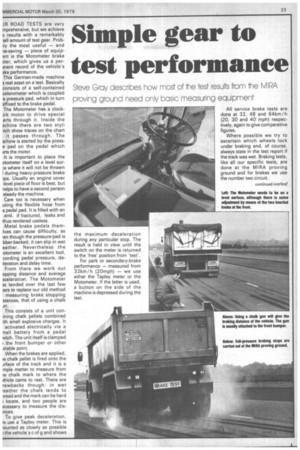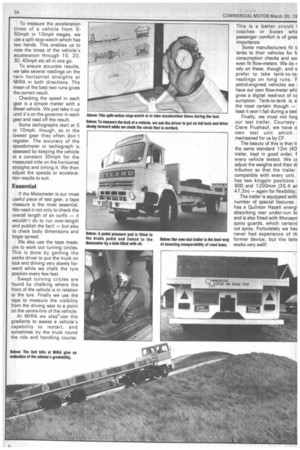Simple gear to test performance
Page 35

Page 36

If you've noticed an error in this article please click here to report it so we can fix it.
Steve Gray describes how most of the test results from the V IRA proving ground need only basic measuring equipment
JR ROAD TESTS are very mprehensive, but we achieve a results with a remarkably Ian amount of test gear. Probily the most useful — and rte-saving — piece of equipant is the Motometer brake ster, which gives us a peranent record of the vehicle's 3ke performance.
This German-made machine 3 real asset on a test. Basically consists of a self-contained celerometer which is coupled a pressure pad, which in turn affixed to the brake pedal.
The Motometer has a clock)rk motor to drive special arts through it. Inside the achine there are two styli lich show traces on the chart it passes through. The achine is started by the presse pad on the pedal which ifts the motor.
It is important to place the otometer itself on a level surwhere it will not be thrown I during heavy-pressure brake )ps. Usually an engine cover level piece of floor is best, but rielps to have a second person steady the machine.
Care too is necessary when uting the flexible hose from e pedal pad. It is filled with an and, if fractured, leaks and thus rendered useless.
Metal brake pedals them Ives can cause difficulty, as 'en though the pressure-pad is bber-backed, it can slip in wet eather. Nevertheless the otometer is an excellent tool, cording pedal pressure, deileration and delay time.
From there we work out opping distance and average aceleration. The Motometer 3s tended over the last few :ars to replace our old method
• measuring brake stopping stances, that of using a chalk in.
This consists of a unit conining chalk pellets combined ith small explosive charges. It activated electrically via a -nail battery from a pedal vitch. The unit itself is clamped the front bumper or other Jitable point.
When the brakes are applied, le chalk pellet is fired onto the
J rf ace of the track and it is a mple matter to measure from le chalk mark to where the ahicle came to rest. There are rawbacks though: in wet eather the chalk tends to Need and the mark can be hard ) locate, and two people are ecessary to measure the disinces.
To give peak deceleration, e use a Tapley meter. This is munted as closely as possible ) the vehicle's c of g and shows the maximum deceleration during any particular stop. The result is held in view until the switch on the meter is returned to the 'free' position from 'test'.
For park or secondary-brake performance — measured from 32km/h (20mph) — we use either the Tapley meter or the Motometer. If the latter is used, a button on the side of the machine is depressed during the test. All service brake tests are done at 32, 48 and 64km /h (20, 30 and 40 mph) respectively, again to give comparative figures.
Where possible we try to ascertain which wheels lock under braking and, of course, always state in the test report if the track was wet. Braking tests, like all our specific tests, are done at the MIRA proving ground and for brakes we use the number two circuit. To measure the acceleration times of a vehicle from 050mph in 10mph stages, we use a split stop-watch which has two hands. This enables us to note the times of the vehicle's acceleration through 10, 20, 30, 40mph etc all in one go.
To ensure accurate results, we take several readings on the twin horizontal straights at MIRA in both directions. The mean of the best two runs gives the correct result.
Checking the speed in each gear is a simple matter with a diesel vehicle. We just take it up until it's on the governor in each gear and read off the result.
Some tachographs start at 5 or 10mph, though, so in the lowest gear they often don't register. The accuracy of the speedometer or tachograph is assessed by keeping the vehicle at a constant 30mph for the measured mile on the horizontal straights and timing it. We then adjust the speeds or acceleration results to suit.
Essential
If the Motometer is our most useful piece of test gear, a tape measure is the most essential. We need it not only to check the overall length of an outfit — it wouldn't do to run over-length and publish the fact! — but also to check body dimensions and bogie spread.
We also use the tape measure to work out turning circles. This is done by getting the works driver to put the truck on lock and driving very slowly forward while we chalk the tyre position every few feet.
Swept turning circles are found by chalking where the front of the vehicle is in relation to the tyre. Finally we use the tape to measure the visibility from the driving seat to a point on the centre-line of the vehicle.
At MIRA we also-use the gradients to assess a vehicle's capability to restart, and sometimes try the truck round the ride and handling course.
This is a better circuit 1 coaches or buses whe passenger comfort is of grea importance.
Some manufacturers fit ti tanks to their vehicles for ft consumption checks and sor even fit flow-meters. We do r rely on these, though, and s prefer to take tank-to-ta readings on tong runs. F petrol-engined vehicles we have our own flow-meter whi gives a digital read-out of cc sumption. Tank-to-tank is s' the most certain though — least it won't fail during a test Finally, we must not forg our test trailer. Courtesy Crane Fruehauf, we have o own test unit which maintained for us by CF.
The beauty of this is that it the same standard 12m (40 trailer, kept in good order, f every vehicle tested. We CC adjust the weights and their di tribution so that the trailer compatible with every unit. has two kingpin positions • 900 and 1200mm (35.4 ar 47.2in) — again for flexibility.
The trailer is equipped with number of special features. has a Quinton Hazell energ, absorbing rear under-run t:q and is also fitted with Monsam spray guards, which certain! cut spray. Fortunately we hav never had experience of th former device, but the latt€ works very well!
























































































